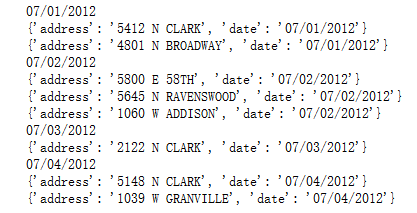Python groupby()
用法一:
groupby()函数扫描整个序列并且查找连续相同值(或根据指定 key 函数返回值相同)的元素序列。
每次迭代,返回一个值和一个迭代器对象。
from operator import itemgetter from itertools import groupby rows = [ {'address': '5412 N CLARK', 'date': '07/01/2012'}, {'address': '5148 N CLARK', 'date': '07/04/2012'}, {'address': '5800 E 58TH', 'date': '07/02/2012'}, {'address': '2122 N CLARK', 'date': '07/03/2012'}, {'address': '5645 N RAVENSWOOD', 'date': '07/02/2012'}, {'address': '1060 W ADDISON', 'date': '07/02/2012'}, {'address': '4801 N BROADWAY', 'date': '07/01/2012'}, {'address': '1039 W GRANVILLE', 'date': '07/04/2012'}, ] for date, items in groupby(rows, key=itemgetter('date')): print(date) for i in items: print(i)

对 groupby() 的使用,最重要的的是要根据指定字段将数据排序,因为 groupby() 仅仅检查连续的元素。
from operator import itemgetter from itertools import groupby rows = [ {'address': '5412 N CLARK', 'date': '07/01/2012'}, {'address': '5148 N CLARK', 'date': '07/04/2012'}, {'address': '5800 E 58TH', 'date': '07/02/2012'}, {'address': '2122 N CLARK', 'date': '07/03/2012'}, {'address': '5645 N RAVENSWOOD', 'date': '07/02/2012'}, {'address': '1060 W ADDISON', 'date': '07/02/2012'}, {'address': '4801 N BROADWAY', 'date': '07/01/2012'}, {'address': '1039 W GRANVILLE', 'date': '07/04/2012'}, ] rows.sort(key=itemgetter('date')) for date, items in groupby(rows, key=itemgetter('date')): print(date) for i in items: print(i)

用法二:
groupby() 函数可以进行数据的分组以及分组后的组内运算。
print(df["评分"].groupby([df["地区"],df["类型"]]).mean())
该条语句的功能:输出数据中不同地区不同类型的评分的平均值。






【推荐】国内首个AI IDE,深度理解中文开发场景,立即下载体验Trae
【推荐】编程新体验,更懂你的AI,立即体验豆包MarsCode编程助手
【推荐】抖音旗下AI助手豆包,你的智能百科全书,全免费不限次数
【推荐】轻量又高性能的 SSH 工具 IShell:AI 加持,快人一步
· Linux系列:如何用heaptrack跟踪.NET程序的非托管内存泄露
· 开发者必知的日志记录最佳实践
· SQL Server 2025 AI相关能力初探
· Linux系列:如何用 C#调用 C方法造成内存泄露
· AI与.NET技术实操系列(二):开始使用ML.NET
· 无需6万激活码!GitHub神秘组织3小时极速复刻Manus,手把手教你使用OpenManus搭建本
· C#/.NET/.NET Core优秀项目和框架2025年2月简报
· Manus爆火,是硬核还是营销?
· 终于写完轮子一部分:tcp代理 了,记录一下
· 【杭电多校比赛记录】2025“钉耙编程”中国大学生算法设计春季联赛(1)